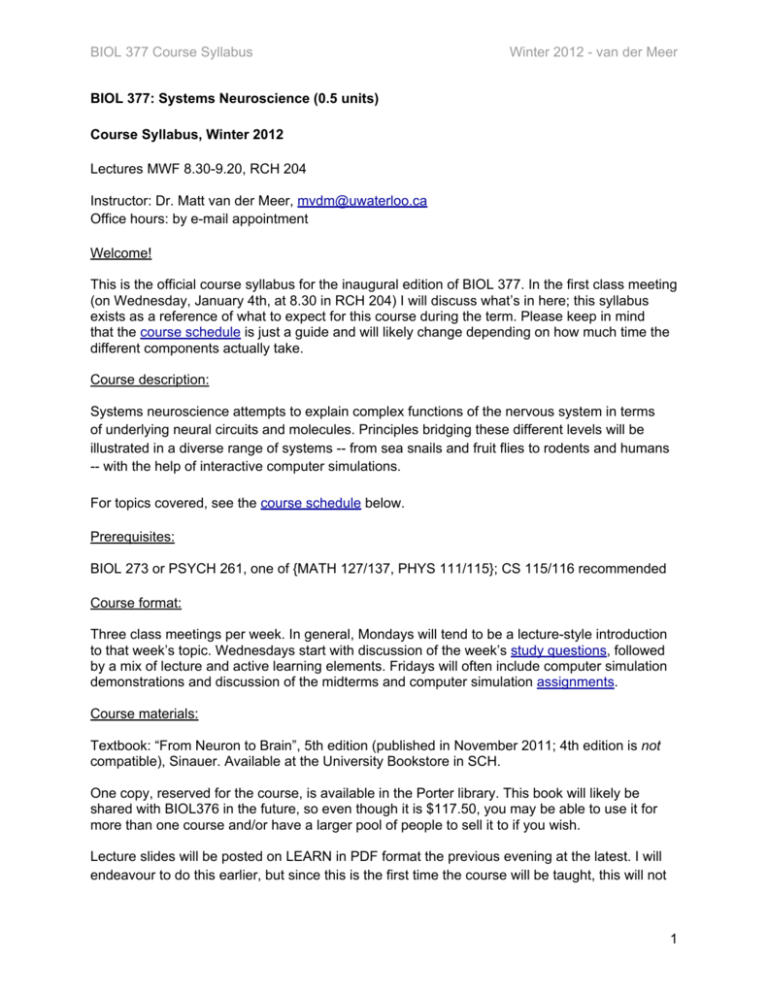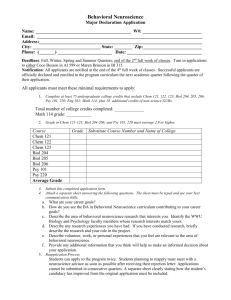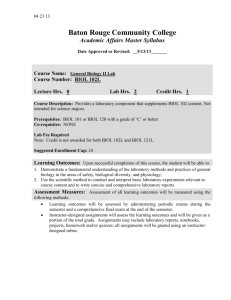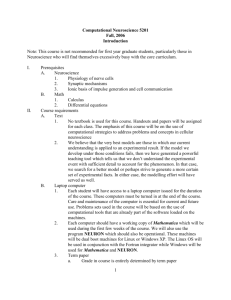BIOL 377 Course Syllabus Winter 2012
advertisement

BIOL 377 Course Syllabus
Winter 2012 - van der Meer
BIOL 377: Systems Neuroscience (0.5 units)
Course Syllabus, Winter 2012
Lectures MWF 8.30-9.20, RCH 204
Instructor: Dr. Matt van der Meer, mvdm@uwaterloo.ca
Office hours: by e-mail appointment
Welcome!
This is the official course syllabus for the inaugural edition of BIOL 377. In the first class meeting
(on Wednesday, January 4th, at 8.30 in RCH 204) I will discuss what’s in here; this syllabus
exists as a reference of what to expect for this course during the term. Please keep in mind
that the course schedule is just a guide and will likely change depending on how much time the
different components actually take.
Course description:
Systems neuroscience attempts to explain complex functions of the nervous system in terms
of underlying neural circuits and molecules. Principles bridging these different levels will be
illustrated in a diverse range of systems -- from sea snails and fruit flies to rodents and humans
-- with the help of interactive computer simulations.
For topics covered, see the course schedule below.
Prerequisites:
BIOL 273 or PSYCH 261, one of {MATH 127/137, PHYS 111/115}; CS 115/116 recommended
Course format:
Three class meetings per week. In general, Mondays will tend to be a lecture-style introduction
to that week’s topic. Wednesdays start with discussion of the week’s study questions, followed
by a mix of lecture and active learning elements. Fridays will often include computer simulation
demonstrations and discussion of the midterms and computer simulation assignments.
Course materials:
Textbook: “From Neuron to Brain”, 5th edition (published in November 2011; 4th edition is not
compatible), Sinauer. Available at the University Bookstore in SCH.
One copy, reserved for the course, is available in the Porter library. This book will likely be
shared with BIOL376 in the future, so even though it is $117.50, you may be able to use it for
more than one course and/or have a larger pool of people to sell it to if you wish.
Lecture slides will be posted on LEARN in PDF format the previous evening at the latest. I will
endeavour to do this earlier, but since this is the first time the course will be taught, this will not
1
BIOL 377 Course Syllabus
Winter 2012 - van der Meer
always be possible. Thank you for your understanding!
Assessment:
1. Weekly study questions: 10 sets of mixed online questions, due on LEARN before
Wednesday’s lecture, all weeks except 1, 8, 13, 14, for 10% overall. Available the previous
Friday at the latest.
2. Written assignments: 3, based on exploration of computer simulations or data from a
neuroscience experiment, submit on LEARN in PDF format before Friday’s lecture, weeks
3, 7, 12, for 25% overall. Available at least one week before deadline, marked before next
assignment available.
3. Mid-term exams: 2, in class, Fridays weeks 5 and 10. Multiple-choice and written questions
for 20% overall.
4. Final exam: in class, Friday week 13, multiple choice and written questions for 25% overall.
As a rule of thumb, you should expect to spend 2.25 hours of homework (reading, question
sets, assignments) per hour of class on average, for a total of ~10 hours per week spent on the
course. If you keep up with the reading, take notes during reading and in class, and do the study
questions, you should not have to do extra work for the midterms and final exams.
The study questions, assignments, and exams will be discussed in class: the goal of having
frequent assessment is so that you have many opportunities to practice your skills, verify your
understanding and progress, and get feedback. If after the class discussion you still have
questions, contact me after class or e-mail me.
Learning Objectives:
At the end of this course, you should be able to:
1. Identify and define concepts relevant to the study and understanding of neural
systems. In the course, you will develop an understanding of these concepts in the context
of specific example systems, with particular attention to those that link different levels of
organization in the brain, such as information processing, neural code, receptive field, the idea
of levels of organization itself, topographical maps, connectivity patterns, neuronal diversity,
synaptic plasticity, neurotransmitter effects, and others.
2. Describe experimental approaches that can be used to investigate the relationship
between behavior and neural systems, by using specific systems (such as the primate visual
system, the rat head direction system, and the leech swimming circuit) as examples.
Course policies:
No make-up anything. If this seems unreasonable, consider that allowing make-up study
questions or exams in a fair manner would mean withholding a set of questions just for makeup purposes. These questions would then only be able to help a very small number of students,
compared to the entire class if they are part of everyone’s course experience. The impact of
missing out a single question set, assignment or exam is mitigated by having many assessed
components in the course. So even if you miss one, you can still do well. For approved
2
BIOL 377 Course Syllabus
Winter 2012 - van der Meer
absences (see here for the proper procedure) this policy also applies in principle, but I will try to
make an exception where possible.
Late submissions. No late submissions for study question sets allowed. Late assignments
incur a 30 percentage point penalty per 24 hours (not prorated, weekends and holidays count).
In class exams. Please arrive by 8.25 so we can begin promptly. Arriving late will disturb your
classmates. Absolutely no textbooks, notes, electronic devices, or other aids allowed! Make
sure you understand uWaterloo’s academic integrity policy: basically, don’t cheat, steal or lie. It
is your responsibility to know what that means!
Assignments and study questions. These exist to help you understand key concepts in the
course by practicing, and will be building blocks for material in the lectures and in the in class
exams. Although are welcome to discuss these with your classmates, bear in mind that what
you submit must ultimately reflect your personal learning process and understanding (see the
tutorial for details). If you submit work that is not your own without acknowledgment, not only will
you be committing an academic integrity offence, but you will also harm your chances of doing
well on the in-class exams.
Course notes. “skeleton notes”, i.e. the lecture slides, will be posted on LEARN the previous
evening at the latest. No other notes will be available: for this course, an important part of the
learning process is the incorporation of class concepts and knowledge into your own thinking.
Respect in the classroom. RCH 204 is a small classroom with a minimal seating gradient, and
will likely be pretty full. Moreover, the amount of personal space available is not large. Thus,
out of respect for your classmates, please refrain from using electronic devices for activities
unrelated to the class. If you find yourself distracted by a classmate, it is perfectly appropriate to
ask if they would move to the back row next time.
Learning styles and disabilities. Acknowledging that not everyone learns the same way, I
work hard to provide multiple different ways of communicating and practicing concepts and
skills, through a combination of spoken and written language; conceptual diagrams, schematics,
and pictures; videos and demonstrations. The Office for Persons with Disabilities can provide
additional resources and accommodation for special needs.
Please see also the official statements from the University and the Faculty of Science at the end
of this document.
Course schedule:
First day of class is January 4 (Wed; week 1); last day is April 2 (Mon; week 14). Week 8 is
reading week (February 20-24, no class).
Please note: this schedule is just a guide. It will be adjusted as we go along depending on how
long things take. Exam contents will be based on what is actually covered, not on this schedule.
Week
Monday
Wednesday
Friday
1
no class (holiday)
welcome, logistics; get
signals, information, and
3
BIOL 377 Course Syllabus
Winter 2012 - van der Meer
textbook, Q1 out
the neural code; install
Nengo
2
brain building blocks:
neuron, projection,
read: Ch1
visual system basics I: eye,
retina (also Q1 discussion)
read: Ch1, due: Q1
modelling the brain:
introduction to Nengo; A1
(representation), Q2 out
3
visual system basics II:
from retina to V1, work
on A1
visual system receptive
fields, simple and complex
cells read: Ch2, due: Q2
techniques in systems
neuroscience, due: A1, Q3
out
4
visual system
architecture: layers,
columns
read: Ch3
channels and the resting
potential I, A1 discussion
read: Ch4, due: Q3
from resting potential to
action potential, read: Ch6,
Q4 out
5
action potential
read: Ch7
glia
read: Ch10, due: Q4
Midterm 1, Q5 out
6
synapses, LTP & LTD,
STDP, read: Ch11
synaptic plasticity
read: Ch16, due: Q5
neurotransmitters and
neuromodulation, read:
Ch14, A2 (computation)
out, Q6 out
7
reinforcement learning
and dopamine
work on A2
movement and basal ganglia
read: Ch24, due: Q6
basal ganglia, due: A2
8
no class
no class
no class, Q7 out
9
A2 discussion, auditory
system
vestibular system, read:
Ch22, due: Q7
development I
read: Ch25 part 1, Q8 out
10
development II
read: Ch25 part II
critical periods
read: Ch26, due: Q8
Midterm 2, Q9 out, A3
(HC data set) out
11
hippocampus, memory, place, head direction, grid
sequences and replay, cells in rats and humans
work on A3
work on A3, due: Q9
navigation: ants, bees,
leeches, read: Ch18,
Q10 out
12
return to the retina;
read Ch20
constructing perception;
read Ch23, due: Q10
touch, pain, texture; due:
A3
13
A3 discussion; read:
Ch21
Final exam Q&A session
(submit questions online)
Final exam
14
open questions,
systems neuroscience
and the future; exit
survey
no class (classes end)
no class (classes end)
4
BIOL 377 Course Syllabus
Winter 2012 - van der Meer
(Key: Qn, study question sets, An, assignments, “out” means a question set or assignment is
available on LEARN)
Relationship to other courses:
BIOL 376 (Cellular Neurophysiology) focuses on the properties of single neurons. Because
single neuron properties shape the networks they are embedded in, this course contains some
material students in 376 will be familiar with. However, in 377, the perspective is firmly on the
implications of single neuron properties for neural systems. 376 and 377 complement each
other in their emphasis on different levels of analysis in the nervous system.
BIOL 477 (planned; Theoretical Neuroscience) differs from 376 and 377 in that it abstracts the
detailed biological mechanisms making up the bulk of those courses’ subject matter. Instead,
477 aims to capture representation and computation in the brain in stripped-down mathematical
terms and simple computer programs. Although 376 and 377 use interactive computer
simulations, these are used as illustrations and do not have the students use equations or
programming.
BIOL 273 (Principles of Human Physiology I) and PSYCH 261 (Physiological Psychology).
Prerequisites for 377, these courses give the students context for more detailed exploration of
the nervous system, as well as some basic familiarity with biological processes.
FAQ:
Why are the CS courses recommended? Two reasons. The first is that because the
assignments for this course are done in a neural simulation package called Nengo, some
familiarity and adaptability to new software is useful. Second, a theme of this course is that
the brain can be productively understood as an information processing device. You will have a
richer understanding of this idea if you have some experience in programming computers to do
information processing.
What are the computer simulations for? The brain is a continually changing, incredibly
complex object. Text and static pictures can only offer a limited understanding of concepts that
are fundamentally about dynamic processes where many elements interact. The computer
simulations offer one way to illustrate such processes. In addition, simulations are interactive,
encouraging active thinking.
Why are the computer simulations in Nengo? Like any model, Nengo does not capture all
known features of the brain. It was chosen for this course because it focuses on the systems
level, of how patterns of activity in related brain areas can represent and transform information.
Thus, it is able to illustrate some of the key concepts in the course. Futhermore, it is a mature
environment which nevertheless continues to be actively expanded and enriched right here in
Waterloo. Thus, in the future, we will be able to adapt it further to this and other courses’ needs
(Nengo is also used in other courses on campus, such as SYDE 556).
Will any programming be required? No. If you are so inclined, however, Nengo is completely
open source with excellent documentation and examples available. Feel free to explore and
create your own brain models!
Will there be any equations to solve? No. However, you will have to understand relationships
5
BIOL 377 Course Syllabus
Winter 2012 - van der Meer
captured by equations and use that understanding to reason qualitatively about the expected
results of certain manipulations (e.g. what happens to a neuron’s resting potential if the
extracellular potassium concentration is increased?)
Are the mid-terms and final exam cumulative? Yes, the midterms and final exam are about
everything in the course up to that point. For this course, it is important that you learn to connect
concepts and skills practiced throughout, rather than keep them compartmentalized without
building on earlier ideas.
Why are there so many graded items (question sets, assignments, exams) in the course?
Remember that this is actually a lot more work for me, compared to having just one or two
exams. I do this because I believe having frequent opportunities for feedback is an important
catalyst for learning and understanding. I want to make sure you can practice the skills on which
you will be assessed, instead of surprising you with them on the final exam. Also, because this
is the first time the course runs, I want to verify understanding so that I can know which parts
are clear and which confusing, and make changes on the fly.
What will be on the exam(s)? Questions similar to the ones in the study question sets. (Hint:
some of them will be very similar!) Topics include those covered by the textbook readings and
assignments, as well as those discussed in the lectures.
How will the assignments, study questions, and exams be graded? Each question will be
worth some number of points. Points scored will be converted into a percentage for each set/
assignment/exam. Your overall mark will be the weighted average of these (see above for the
specific weighting). Should very strange distributions result, I reserve the right to “grade on a
curve”, but I really hate doing this.
Why does the textbook (and the course) start with the visual system? I think most
neuroscience textbooks are boring, because they treat the brain as a collection of separate bits
and pieces, and only at the end, if you’re lucky, say something about how the bits go together.
This book, and this course, is different. We start with a real system to motivate and give context
to discussion of the bits.
Why is the textbook so hard to follow? One reason may be because we start “in the middle”,
with the visual system, instead of with individual components, like a neuron or channel. (See the
question above.) Another reason is that the book is written to encourage, even require, active
processing of the material. A deeper reason is that the brain is an immensely complex object
which requires many different perspectives and tools in order to study it.
Is this course going to be hard? Fundamentally, neuroscience is an interdisciplinary subject
where even well-established scientists continually learn important information that was already
well known to others. This course will give you a flavour for the range of concepts, tools and
approaches. A major reason for the frequent feedback is to allow you to be fearless in exploring
these; if you keep up with the study question sets you will be well prepared for the exams. As
mentioned above, expect to spend 2-3 hours per hour of lectures on homework.
Will you be using anti-plagiarism tools such as Turnitin? No. But as you’ll learn in the
course, human brains are great at detecting patterns, so don’t take this as an invitation!
6
BIOL 377 Course Syllabus
Winter 2012 - van der Meer
Why is a section of the course on material that is not in the textbook? Maybe someday I
will write my own! For now, none of the available textbooks overlaps exactly with my experience
and my goals for this course given your backgrounds. The section that is not in the book is an
opportunity for you to apply what you have learned to a new setting, which really shows your
progress in the course!
I couldn’t make lecture x. Did I miss anything? Yes. The slides will be available on LEARN,
but they will be hard to understand without knowing what was said. The study questions and
their discussion will address some of the most important concepts.
What kind of work does your lab do? We work on a number of projects pertaining to
decision-making and planning in rats. We can record from up to 200 neurons simultaneously,
from multiple brain structures, as rats engage in decision tasks. A better understanding how
representations of potential outcomes impact behavior will help us explain how decision-making
processes go wrong, such as occurs in addiction and obsessive-compulsive behaviour. The lab
website, www.vandermeerlab.org, has an overview, a gallery highlighting some key results, and
all our recent publications.
Can I do a USRA/499/work-study/co-op project in your lab? I’m always looking for motivated
and talented students to join our team. Because of the extensive training you will receive and
the cost of the materials and subjects you will be working with, preference will be given to
students who can commit to multiple consecutive terms in the lab (e.g. USRA followed by two
499 terms). Outstanding marks are a plus, as is previous lab experience; however other skills
such as programming, signal processing and rapid prototyping can also be valuable.
Is it true there is going to be an undergraduate neuroscience program at Waterloo? An
Honours BSc Neuroscience program is in advanced stages of approval, but not fully confirmed
yet as of Jan 2012. The proposed program will be 2nd year entry, have a set of core courses
including a neuroscience-specific lab course equipped with 10 electrophysiology workstations,
and a strong mathematics, statistics, and computer science foundation. First entry is expected
in 2013 or 2014.
Where can I find more neuroscience? At Waterloo, there are several neuroscience courses
available in multiple departments (check Biology, Psychology, Kinesiology, Systems Design
Engineering; I hope the proposed neuroscience program, above, will make these easier to
find and access). All of these departments regularly host Neuroscience talks, symposia, and
outreach events. We also have Canada’s only Centre for Theoretical Neuroscience, which has
a great seminar series as well as the annual “Brain Day”. There are neuroscience summer
schools for undergraduates. e.g. at Penn. If you are thinking of graduate school, make sure
you have a strong undergraduate record with substantial research experience and evidence
of initiative and leadership. Online resources include neuroscience feature videos from PBS,
HHMI, and material from Neuroscience for Kids, the Society for Neuroscience, and many
others.
Messages from the University of Waterloo and the Faculty of Science:
1. To create and promote a culture of academic integrity, the behaviour of all members of the
University of Waterloo should be based on honesty, trust, fairness, respect and responsibility.
2. Note on avoidance of academic offences:
7
BIOL 377 Course Syllabus
Winter 2012 - van der Meer
All students registered in the courses of the Faculty of Science are expected to know
what constitutes academic integrity, to avoid committing academic offences, and to take
responsibility for their actions. When the commission of an offence is established, disciplinary
penalties will be imposed in accord with Policy #71 (Student Discipline). For information on
categories of offences and types of penalties, students are directed to consult Policy #71
(http://www.adm.uwaterloo.ca/infosec/Policies/policy71.htm). If you need help in learning what
constitutes an academic offence; how to avoid offences such as plagiarism, cheating, and
unauthorized resubmission of work; how to follow appropriate rules with respect to “group work”
and collaboration; or if you need clarification of aspects of the discipline policy, ask your TA and/
or your course instructor for guidance. Other resources regarding the discipline policy are your
academic advisor and the Undergraduate Associate Dean.”
3. Students who believe that they have been wrongfully or unjustly penalized have the right to
grieve; refer to Policy #70, Student Petitions and Grievances, http://www.adm.uwaterloo.ca/
infosec/Policies/policy70.htm.
4. Concerning a decision made under Policy 33 (Ethical Behaviour), Policy 70 (Student Petitions
and Grieveances) or Policy 71 (Student Discipline), a student may appeal the finding, the
penalty, or both. Students who believe that they have grounds for an appeal should refer to
Policy 72 (Student Appeals) http://www.adm.uwaterloo.ca/infosec/Policies/policy72.htm.
5. Note for students with disabilities: The Office for Persons with Disabilities (OPD), located in
Needles Hall, Room 1132, collaborates with all academic departments to arrange appropriate
accommodations for students with disabilities without compromising the academic integrity of
the curriculum. If you require academic accommodations to lessen the impact of your disability,
please register with the OPD at the beginning of each academic term.
8





